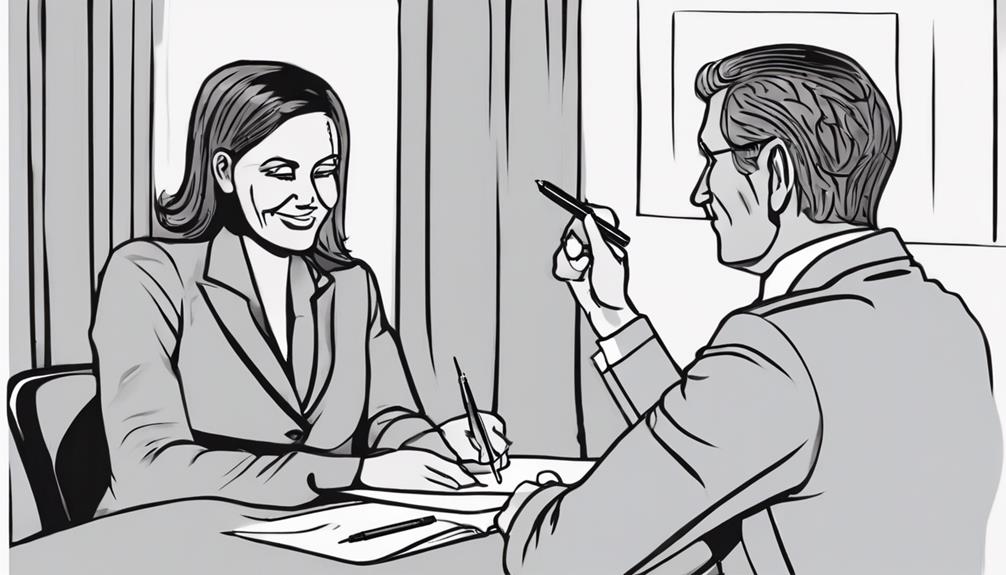To ensure a successful subliminal hypnosis session, prioritizing explicit and ongoing client consent is paramount. Establishing clear communication through verbal and non-verbal cues is essential to foster collaboration. Understanding and respecting boundaries create a safe environment for clients. Informed participation empowers clients and promotes trust. Documenting consent processes ensures legal compliance and client safety. Regular check-ins maintain ethical standards and client comfort. Respect for autonomy and ethical responsibilities are fundamental. Exploring the importance of client understanding and empowerment further enhances the quality of subliminal hypnosis sessions.
Importance of Consent

The importance of obtaining explicit consent in subliminal hypnosis sessions cannot be overstated in ensuring ethical and respectful practices in the field. Power dynamics play a significant role in hypnosis, with the hypnotist holding influence over the client's subconscious mind. Without consent, this power dynamic can be exploited, leading to potential harm and ethical concerns.
By prioritizing consent, trust building becomes a foundational element of the hypnosis session. When clients feel respected and empowered to give or withhold consent, a safe and trusting environment is established. This trust is essential for the client to feel comfortable and open to the suggestions presented during the session.
Moreover, clear consent ensures that the client is an active participant in their own subconscious exploration, rather than feeling coerced or manipulated. It also serves as a form of protection for both the client and the hypnotist, setting clear boundaries and expectations for the session.
Clear Communication Methods
Effective communication methods are crucial in subliminal hypnosis sessions to ensure clarity and understanding between the hypnotist and the client. Utilizing both verbal and non-verbal cues is essential in creating a harmonious interaction. Non-verbal cues, such as gestures, eye contact, and facial expressions, can convey messages that complement the spoken words and help establish rapport.
Body language plays a significant role in subliminal hypnosis sessions, as it can indicate the client's comfort level, engagement, or potential discomfort. The hypnotist should pay close attention to the client's body language to adjust their approach accordingly and ensure the client feels safe and respected throughout the session. Open and welcoming body language from the hypnotist can also help the client feel more at ease and receptive to the suggestions being made.
Incorporating both verbal and non-verbal communication methods allows for a comprehensive understanding between the hypnotist and the client, fostering a trusting and collaborative environment conducive to successful hypnosis sessions.
Understanding Boundaries

How can the establishment and acknowledgment of boundaries enhance the dynamics of subliminal hypnosis sessions?
Boundary awareness is a fundamental aspect of creating a safe and respectful environment for both the hypnotist and the client.
In the context of subliminal hypnosis, understanding and respecting boundaries are crucial for promoting trust and ensuring that the client feels secure throughout the session.
Consent education plays a pivotal role in helping both parties recognize and uphold these boundaries effectively.
Informed Client Participation
Client engagement is a critical factor in ensuring the efficacy and ethicality of subliminal hypnosis sessions. To achieve this, client empowerment through trust building is essential. Establishing a foundation of trust allows clients to feel secure and open to the hypnotic process.
Consent education plays a pivotal role in informed client participation. By educating clients on the nature of hypnosis, potential outcomes, and the importance of active involvement, mutual understanding is fostered between the hypnotist and the client.
Encouraging clients to actively participate in the session enhances their sense of control and autonomy. This involvement can lead to a more profound hypnotic experience, as the client feels empowered in the process. Moreover, when clients are well-informed and engaged, they are more likely to experience the desired benefits of hypnosis.
Building a collaborative relationship based on transparency and consent education is key to ensuring that clients have a positive and meaningful experience during subliminal hypnosis sessions.
Consent Documentation Process

What steps are involved in the consent documentation process for subliminal hypnosis sessions?
The consent documentation process is a crucial aspect of ensuring client safety, legal compliance, and adherence to session protocols.
Prior to the commencement of any subliminal hypnosis session, it is imperative to obtain explicit consent from the client. This involves clearly explaining the nature of the session, potential risks, benefits, and any other relevant information to the client.
Consent verification is typically documented through a consent form that the client reads, understands, and signs before the session begins. This form serves as a legal document confirming that the client has provided informed consent to participate in the hypnosis session.
Additionally, it is essential to keep detailed records of the consent documentation process to demonstrate legal compliance and adherence to session protocols.
Continuous Consent Check-ins
Ensuring continuous consent check-ins throughout subliminal hypnosis sessions is paramount in maintaining ethical standards and prioritizing client well-being. Trust building is a cornerstone of any therapeutic relationship, especially in a vulnerable state induced by hypnosis. To uphold this trust, practitioners must regularly check in with clients during sessions to ensure ongoing consent.
Nonverbal cues play a crucial role in these check-ins. While verbal affirmation is essential, paying attention to the client's body language, facial expressions, and overall demeanor can provide valuable insights into their comfort levels. If a client exhibits signs of distress or discomfort, it is imperative to pause the session immediately and address their concerns.
Continuous consent check-ins not only demonstrate respect for the client's autonomy but also contribute to a safe and supportive therapeutic environment. By integrating these check-ins seamlessly into the session, practitioners can foster a sense of trust and openness, enhancing the overall effectiveness of subliminal hypnosis therapy.
Respect for Autonomy

How can practitioners in subliminal hypnosis therapy demonstrate a deep respect for client autonomy?
Respecting autonomy rights is fundamental in any therapeutic setting, including subliminal hypnosis. Practitioners must uphold the principle of autonomy by recognizing and honoring the client's right to make decisions about their own treatment. This involves providing clear information about the process, potential risks, and benefits, allowing the client to give informed consent based on a comprehensive understanding.
Establishing consent boundaries is crucial in demonstrating respect for autonomy. Practitioners should outline what will occur during the session, ensuring that the client understands and agrees to each step. Clients must feel empowered to voice any discomfort or request modifications during the hypnosis process, knowing that their boundaries will be respected.
Additionally, practitioners should refrain from using coercive language or tactics that may undermine the client's ability to freely consent.
Ethical Responsibility
Demonstrating ethical responsibility in subliminal hypnosis therapy requires practitioners to adhere to established ethical guidelines and standards of practice. Upholding ethical obligations is paramount in ensuring the well-being of clients and maintaining their trust in the therapeutic process.
Practitioners must prioritize the principle of beneficence, acting in the best interest of the client while avoiding harm. This includes obtaining informed consent, respecting confidentiality, and safeguarding the client's autonomy throughout the hypnosis session.
Furthermore, ethical responsibility extends to the practitioner's competence and ongoing professional development. It is essential for practitioners to stay abreast of current research, trends, and best practices in subliminal hypnosis therapy to provide the highest quality of care to their clients.
Transparency and honesty are integral components of ethical responsibility, fostering a trusting and collaborative relationship between the practitioner and the client.
Frequently Asked Questions
Can Subliminal Hypnosis Be Effective Without Explicit Verbal Consent?
In the realm of subliminal hypnosis, the effectiveness of techniques without explicit verbal consent raises ethical concerns surrounding informed consent and boundaries. Ensuring proper consent is essential to uphold ethical standards and respect individual autonomy.
How Can Non-Verbal Cues Be Utilized in Consent During Hypnosis?
In the realm of hypnosis, non-verbal communication and body language cues play a crucial role in understanding consent. These subtle indicators, when carefully observed and interpreted, can offer valuable insight into a client's willingness and engagement during a session.
Is It Necessary to Revisit Consent During Every Hypnosis Session?
Revisiting consent in every hypnosis session is crucial to maintaining trust, respecting boundaries, and understanding evolving dynamics. Regularly reaffirming consent fosters a safe and ethical environment, ensuring that all parties are comfortable and empowered throughout the process.
What Measures Can Be Taken if a Client Breaches Established Boundaries?
Boundary enforcement is crucial in maintaining a safe therapeutic environment. When a client breaches established boundaries, consequences must be clearly communicated and implemented to uphold the therapeutic relationship. Clients must understand their responsibility and the potential consequences.
Are There Any Specific Ethical Guidelines for Advertising Subliminal Hypnosis Services?
When considering ethical advertising for subliminal hypnosis services, it is crucial to uphold transparency, accuracy, and respect for potential clients' autonomy. Non-verbal cues should align with ethical principles to ensure informed decision-making.
Conclusion
In conclusion, ensuring consent in subliminal hypnosis sessions is crucial for maintaining ethical standards and respecting the autonomy of clients.
By employing clear communication methods, understanding boundaries, and consistently checking in with clients, practitioners can create a safe and respectful environment for all parties involved.
It is imperative that all hypnosis sessions are conducted with informed client participation and documented consent to uphold ethical responsibility in the practice.
